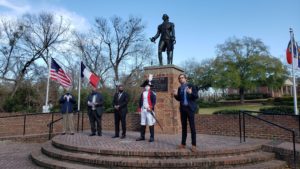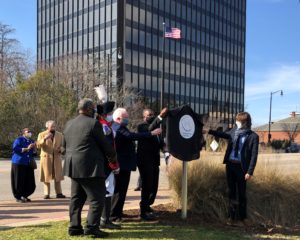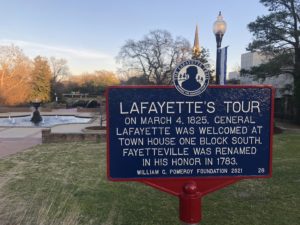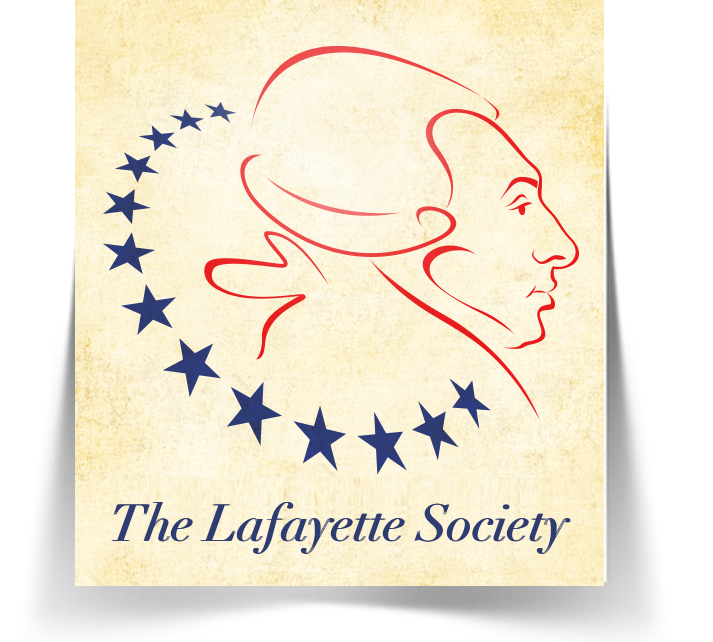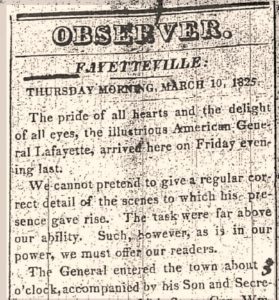Join Lafayette as He Traces His Steps in Fayetteville
The March 10, 1825 edition of the Carolina Observer (predecessor to today’s Fayetteville Observer) ran an extensive account of the General’s visit:
The pride of all hearts and the delight of all eyes, the illustrious American General Lafayette, arrived here on Friday evening last. We cannot pretend to give a regular correct detail of the scenes to which his presence gave rise. The task were far above our ability. Such, however, as is in our power, we must offer our readers. The general entered the town about 3 o’clock… [Read more]
Every Story Needs a Good Storyteller…
During his 1824-1825 tour of the United States, Lafayette was accompanied by his secretary Auguste Lavasseur. Lavasseur’s chronicle, Lafayette in America in 1824 and 1825 : or, Journal of Travels in the United States, has been translated from the French numerous times over the last few centuries, but the 2007 edition by American Friends of Lafayette president Alan Hoffman is the only unabridged English translation. The images below are from an 1829 edition published in New York by White, Gallaher, and White (From the Methodist University Lafayette Collection). Unfortunately, the translator is not credited. [A transcription follows the images.]
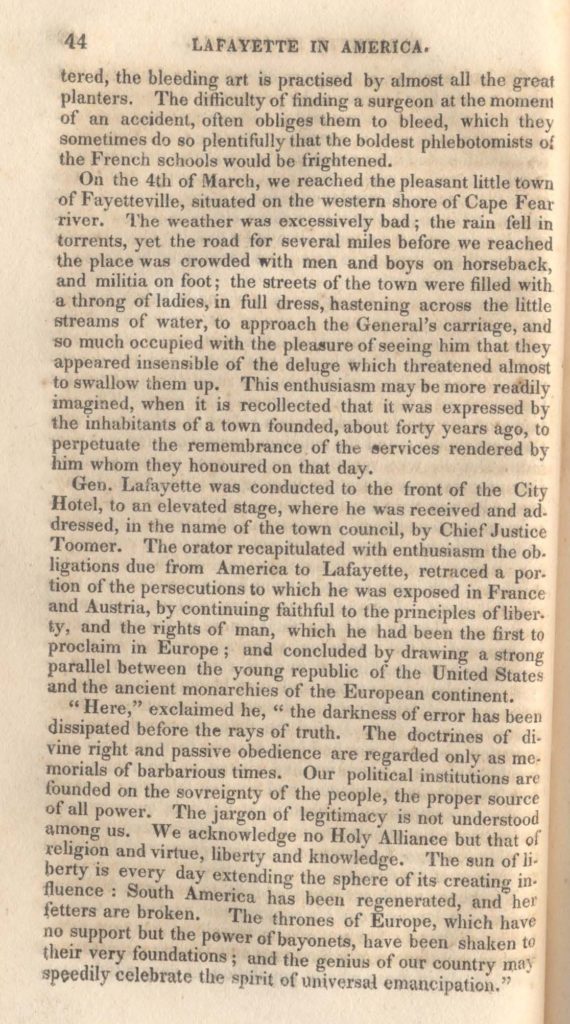
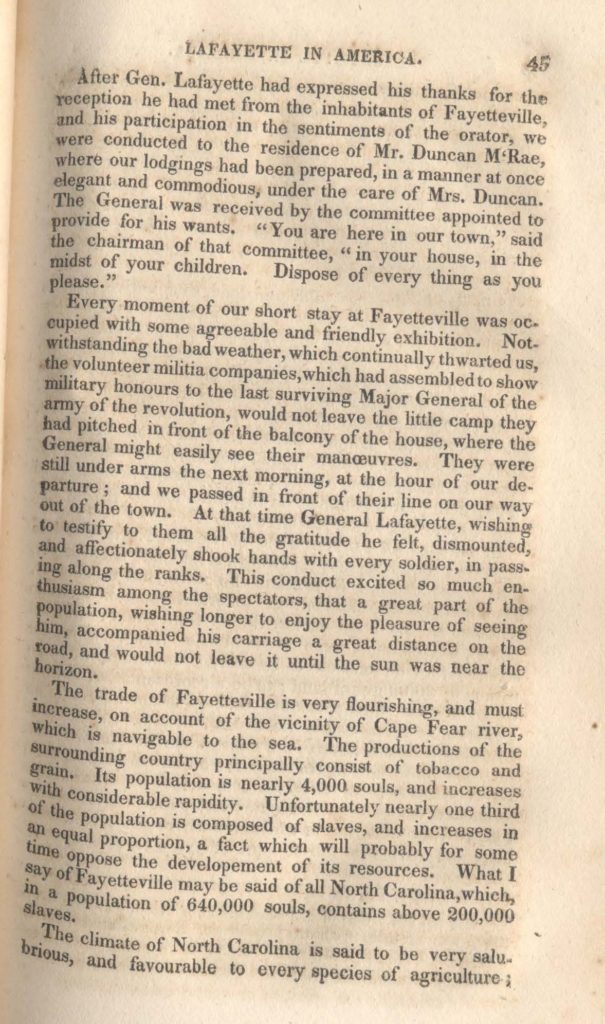
(p.44) On the 4th of March, we reached the pleasant little town of Fayetteville, situated on the western shore of the Cape Fear river. The weather was excessively bad; the rain fell in torrents, yet the road for several miles before we reached the place was crowded with men and boys on horseback, and militia on foot; the streets of the town were filled with a throng of ladies, in full dress, hastening across the little streams of water, to approach the General’s carriage, and so much occupied with the pleasure of seeing him that they appeared insensible of the deluge which threatened almost to swallow them up. This enthusiasm may be more readily imagined, when it is recollected that it was expressed by the inhabitants of a town founded, about forty years ago, to perpetuate the remembrance of the services rendered by him whom they honoured on that day.
Gen. Lafayette was conducted to the front of the City Hotel, to an elevated stage, where he was received and addressed, in the name of the town council, by Chief Justice Toomer. The orator recapitulated with enthusiasm the obligations due from America to Lafayette, retraced a portion of the persecutions to which he was exposed in France and Austria, by continuing faithful to the principles of liberty, and the rights of man, which he had been the first to proclaim in Europe; and concluded by drawing a strong parallel between the young republic of the United States and the ancient monarchies of the European continent.
“Here,” exclaimed he, “the darkness of error has been dissipated before the rays of truth. The doctrines of divine right and passive obedience are regarded only as memorials of barbarous regimes. Our political institutions are founded on the sovereignty of the people, the proper source of all power. The jargon of legitimacy is not understood among us. We acknowledge no Holy Alliance but that of religion and virtue, liberty and knowledge. The sun of liberty is every day extending the sphere of its creating influence; South America has been regenerated, and her fetters are broken. The thrones of Europe, which have no support but the power of bayonets, have been shaken to their very foundations; and the genius of our country may speedily celebrate the spirit of universal emancipation.”
(p. 45) After Gen. Lafayette had expressed his thanks for the reception he had met from the inhabitants of Fayetteville, and his participation in the sentiments of the orator, we were conducted to the residence of Mr. Duncan M’Rae, where our lodgings had been prepared, in a manner at once elegant and commodious, under the care of Mrs. Duncan. The General was received by the committee appointed to provide for his wants. “You are here in our town,” said the chairman of that committee, “in your house, in the midst of your children. Dispose of everything as you please.”
Every moment of our short stay in Fayetteville was occupied with some agreeable and friendly exhibition. Notwithstanding the bad weather, which continually thwarted us, the volunteer militia companies, which had assembled to show military honours to the last surviving Major General of the army of the revolution, would not leave the little camp they had pitched in front of the balcony of the house, where the General might easily see their manoeuvres. They were still under arms the next morning, at the hour of our departure; and we passed in front of their line on our way out of the town. At that time General Lafayette, wishing to testify to them all the gratitude he felt, dismounted and affectionately shook hands with every soldier, in passing along the ranks. This conduct excited so much enthusiasm among the spectators, that a great part of the population, wishing longer to enjoy the pleasure of seeing him, accompanied his carriage a great distance on the road, and would not leave it until the sun was near the horizon.
… but Lafayette Liked to Tell His Own Stories, Too!
Lafayette didn’t leave all the storytelling to his secretary Levasseur. Apparently the General liked to write – there are over 10,000 letters written by Lafayette still in existence! On March 5, 1825, before he left Fayetteville, Lafayette took a moment to write home. (This letter is part of the Dean Lafayette Collection at Cornell University.) [A translation and transcription follows the images.]
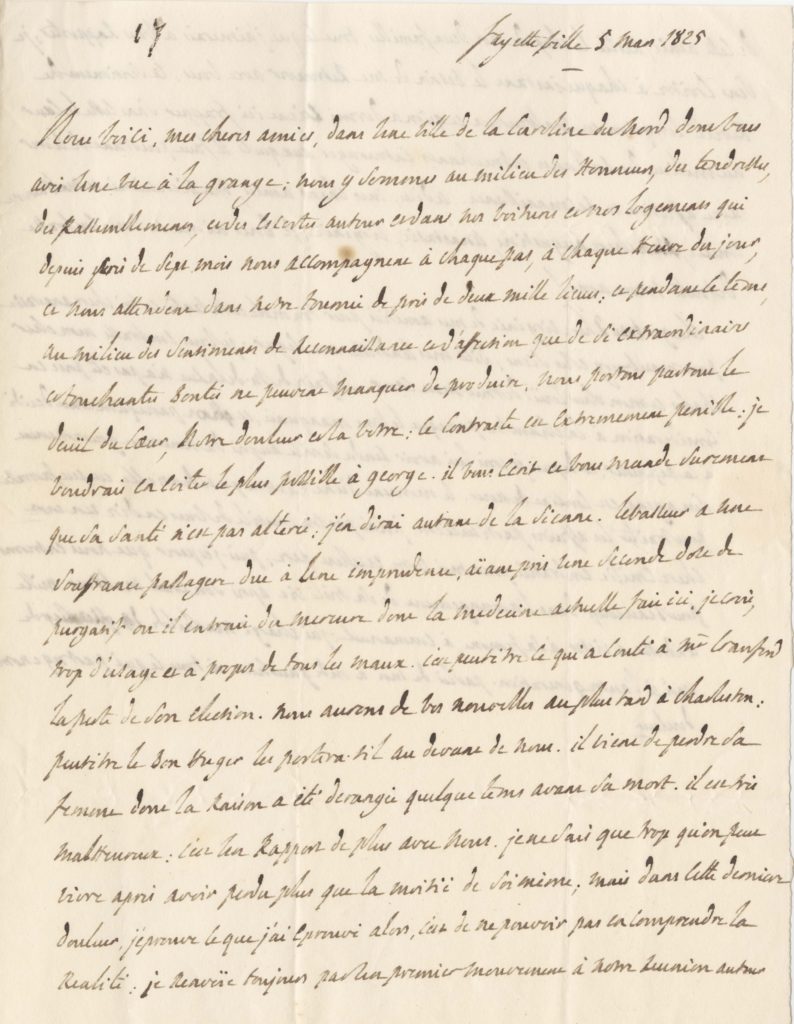
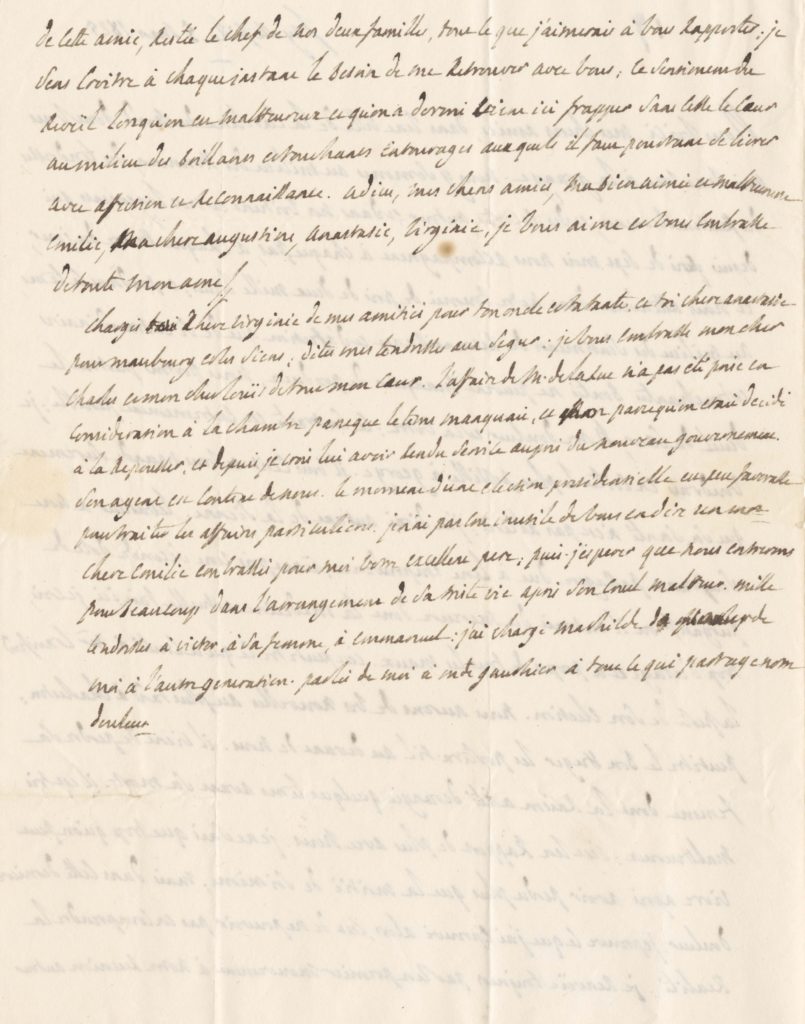
Here we are, my dears[1], in this town of North Carolina which you have seen in a picture at Lagrange[2]; we are in the midst of honors, affection, rallies and escorts in and around our carriages and lodging, which, after nearly seven months, accompany us at every step, at every hour of the day, waiting for us in our tour of nearly two thousand miles, and, meanwhile, amid the feelings of gratitude and affection that such extraordinary kindnesses cannot fail to produce, we remain heartsick[3]. This contrast is extremely painful. We’ll have your news later in Charles Town; perhaps that good man Huger will meet us: he just lost his wife and is very melancholy; this is another thing we have in common.
Farewell, my dears. At every moment I feel the need to return to you; this feeling of alarm, which brings a bad feeling when I sleep, strikes my heart unceasingly amid the bright and touching assemblies that I must engage with affection and gratitude … I always recall, at the slightest provocation, the loss of the matriarch of our two families[4] – I want to tell you everything.
[1] According to Gottschalk, he was writing to his family at La Grange.
[2] Lafayette had an engraving of Fayetteville hanging at La Grange – see Mack’s Life of Gilbert Motier de Lafayette… (1841)
[3] Or, I remain homesick – ?
[4] Madame de Tracy, the mother-in-law of Lafayette’s son George, who had died several weeks before.
Nous voici, mes cheres amies, dans cette ville de la Caroline du nord dont vous avez une vue a Lagrange; nous y sommes au milieu des honneurs, des tendresses, des rassemblements et des escortes autour et dans nos voitures et nos logements, qui, depuis pres de sept mois, nous accompagnent a chaque pas, a chaque heure du jour, nous attendent dans notre tournee de pres de deux mille lieues, et, pendant ce temps, au milieu des sentiments de reconnaissance et d’affection que de si extraordinaires bontes ne peuvent manquer de produire, nous conservons partout le deuil du coeur. Ce contraste est extremement penible. Nous aurons de vos nouvelles au plus tard a Charles-Town; peur-etre le bon Huger les portera-t-il au devant de nous: il vient de perdre sa femme et il est bien malheureux; c’est un rapport de plus avec nous.
Adieu, mes cheres amies, je sens croitre a chaque instant le besoin de me retrouver avec vous; ce sentiment du reveil, lorsqu’on est malheureux et qu’on a dormi, vient frapper sans cesse le coeur au milieu des brillants et touchants entourages auxquels il faut pourtant se livrer avec affection et reconnaissance… Je renvoir toujours, par un premier mouvement, a notre reunion pres de cette amie restee le chef de nos deux familles, tout ce que j’aimerais a vous rapporter.
Did you know that Lafayette had a drawing of Fayetteville over his bed?
In Lafayette’s letter above, he calls Fayetteville “this town of North Carolina which you have seen in a picture at Lagrange.” Why did he have a picture of our town? You can read the story below, from Recollections of the Private Life of General Lafayette by Jules M. Cloquet (London : Baldwin and Cradock, 1835; from the Methodist University Lafayette Collection.) [A transcription follows the images.]
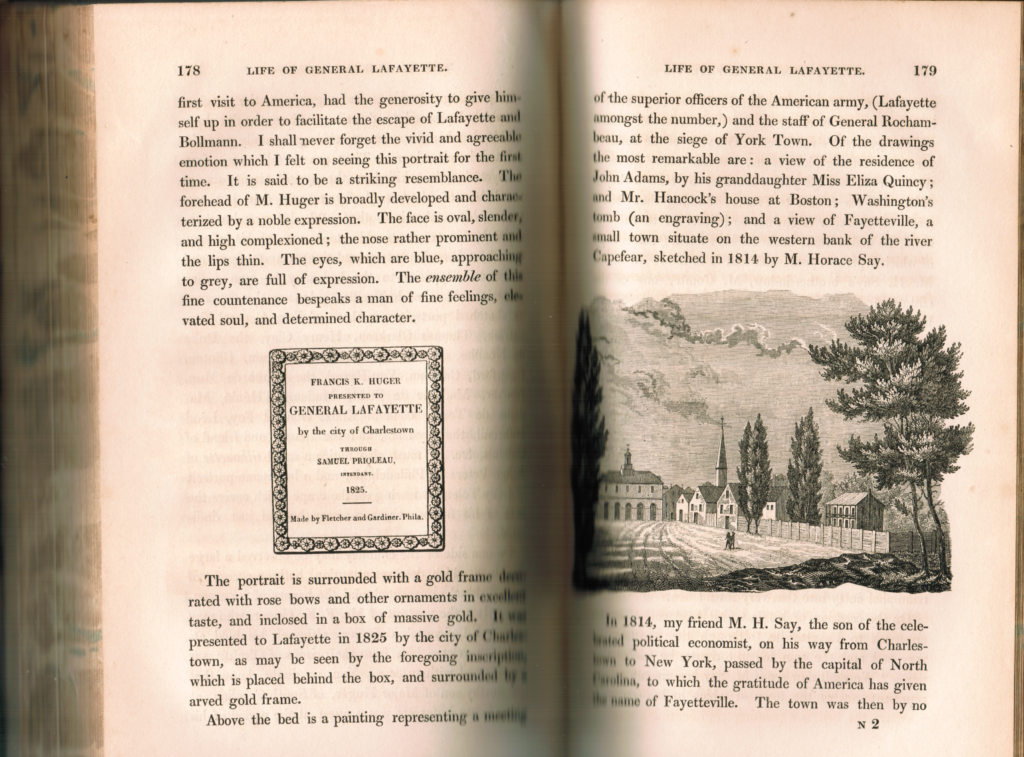
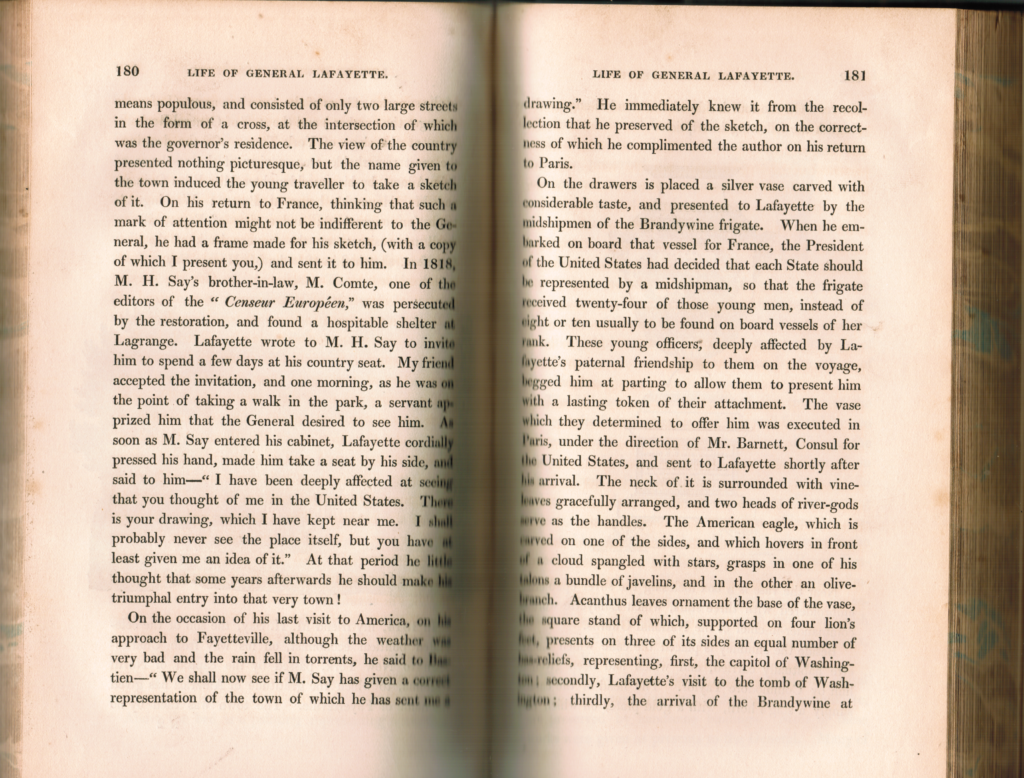
[Cloquet is describing La Grange (Lafayette’s chateau), and gets to Lafayette’s bedroom…]
Above the bed is a painting representing a meeting of the superior officers of the American army, (Lafayette amongst the number,) and the staff of General Rochambeau at the siege of York Town. Of the drawings the most remarkable are: a view of the residence of John Adams, by his granddaughter Miss Eliza Quincy; and Mr. Hancock’s house at Boston; Washington’s tomb (an engraving); and a view of Fayetteville, a small town situate on the western bank of the river Capefear, sketched in 1814 by M. Horace Say.
In 1814, my friend M. H. Say, the son of the celebrated political economist, on his way from Charlestown to New York, passed by the capital of North Carolina, to which the gratitude of America has given the name of Fayetteville. The town was then by no means populous, and consisted of only two large streets in the form of a cross, at the intersection of which was the governor’s residence. The view of the country presented nothing picturesque, but the name given to the town induced the young traveler to take a sketch of it. On his return to France, thinking that such a mark of attention might not be indifferent to the General, he had a frame made for his sketch, (with a copy of which I present to you,) and sent it to him. In 1818, M. H. Say’s brother-in-law, M. Comte, one of the editors of the “Censeur Européen,” was persecuted by the restoration, and found a hospitable shelter at Lagrange. Lafayette wrote to M. H. Say to invite him to spend a few days at his country seat. My friend accepted the invitation, and one morning, as he was on the point of taking a walk in the park, a servant apprized him that the General desired to see him. As soon as M. Say entered his cabinet, Lafayette cordially pressed his hand, made him take a seat by his side, and said to him – “I have been deeply affected at seeing that you thought of me in the United States. There is your drawing, which I have kept near me. I shall probably never see the place itself, but you have at least given me an idea of it.” At that period he little thought that some years afterwards he should make his triumphal entry into that very town!
On the occasion of his last visit to America, on his approach to Fayetteville, although the weather was very bad and the rain fell in torrents, he said to Bastien – “We shall now see if M. Say has given a correct representation of the town of which he has sent me a drawing.” He immediately knew it from the recollection that he preserved of the sketch, on the correctness of which he complimented the author on his return to Paris.
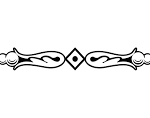
Say’s drawing also merited a mention in Ebenezer Mack’s 1841 book The Life of Gilbert Motier de Lafayette : a Marquis of France ; a General in the American and French Revolutions ; the Compatriot and Friend of Washington ; the Champion of American Independence and of the Rights and Liberties of Mankind : from Numerous and Authentick Sources (Ithaca, NY : Mack, Andrus, & Woodruff, 1841; from the Methodist University Lafayette Collection). [A transcription follows the image.]
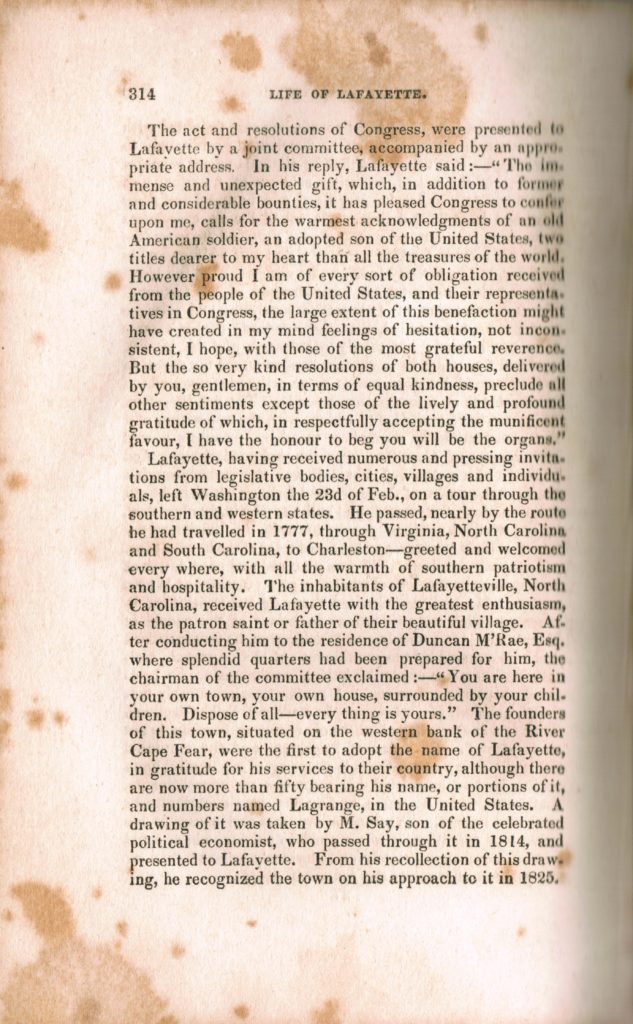
“Lafayette, having received numerous and pressing invitations from legislative bodies, cities, villages, and individuals, left Washington the 23d of Feb., on a tour through the southern and western states. He passed, nearly by the route he had travelled in 1777, through Virginia, North Carolina and South Carolina, to Charleston – greeted and welcomed every where, with all the warmth of southern patriotism and hospitality. The inhabitants of Lafayetteville, North Carolina, received Lafayette with the greatest enthusiasm as the patron saint or father of their beautiful village. After conducting him to the residence of Duncan M’Rae, Esq. where splendid quarters had been prepared for him, the chairman of the committee exclaimed: — “You are here in your own town, your own house, surrounded by your children. Dispose of all – every thing is yours.” The founders of this town, situated on the western bank of the River Cape Fear, were the first to adopt the name of Lafayette, in gratitude for his services to their country, although there are now more than fifty bearing his name, or portions of it, and numbers named Lagrange, in the United States. A drawing of it was taken by M. Say, son of the celebrated political economist, who passed through it in 1814, and presented to Lafayette. From his recollection of this drawing he recognized the town on his approach to it in 1825.”

So How Did Fayetteville Come To Be Named for Lafayette, Anyway?
Compiled by Lafayette Society member Mike Samperton
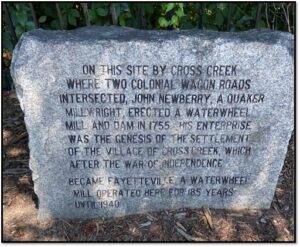
1755: Cross Creek begins
This granite marker is located near the intersection of Cross Creek and Green Street and tells how Fayetteville was first established.
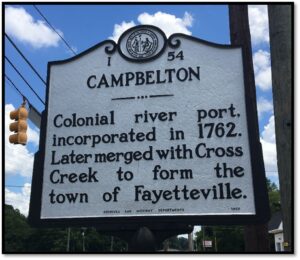
This marker is located on Person Street near the Cape Fear River.
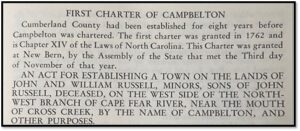
1762: Campbelton is chartered
(from The Story of Fayetteville by John A. Oates)
This Act was passed December 11, 1762.
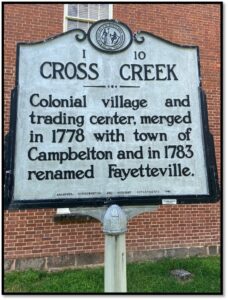
This marker is located at Liberty Point.
 1778: Cross Creek and Campbelton united
1778: Cross Creek and Campbelton united
(from The Story of Fayetteville by John A. Oates)
This Act was passed May 2, 1778.
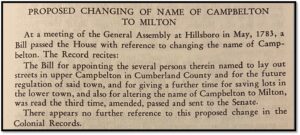
1783: Fayetteville is born
(from The Story of Fayetteville by John A. Oates)
However, in the NC General Assembly Senate minutes recorded on Tuesday, 13 May 1783:
On motion, agreed that the determination of this House for deferring the reading the bills for appointing the several persons therein named to lay out streets in upper Campbelton, in Cumberland County, and for the future regulation, of said town and for giving a further time for saving lots in the lower town, and also for altering the name of Campbelton to Milton be rescinded, whereupon ordered, that this bill be read. The same being read was amended, passed the first time, and sent to the Commons.
At the conclusion of the legislative session on 17 May 1783 the following law was read three times and ratified in the General Assembly.
CHAPTER XXV
An Act for appointing the several persons therein named to lay out the streets in Upper Campbelton, in Cumberland County, and for the future regulation of the said town, and giving a further time for saving of lots in the lower town, and also for altering the name of Campbelton to Fayetteville.
Further specifics:
- Be it Enacted by the General Assembly of the State of North Carolina, and it is hereby Enacted by the authority of the same, that from and after the passing of this Act, the town of Campbelton shall be called and known by the name of Fayetteville, and the two parts thereof shall be distinguished by the name of the upper and lower town; and that Thomas Wade, James Gillespie, John Hay, Thomas Owen, Ambrose Ramsey, Matthew Jones, and Thomas Person, esquires, or a majority of them be, and they are hereby appointed commissioners for laying out the streets of the said town in the most regular and convenient manner in which the same can be done and with as little injury to the proprietors of lots and houses therein as may be, and that the principal streets be one hundred feet wide, and all other streets as wide as the particular situation of houses and lots will admit; and the said commissioners or a majority of them are hereby directed to lay out a square or squares for public buildings, in such part of the said town as may be found most eligible, and of such ground as may be offered for that purpose by any of the proprietors, and take a conveyance or conveyances of the same for the use or uses for which such square or squares shall be laid off, and set apart.
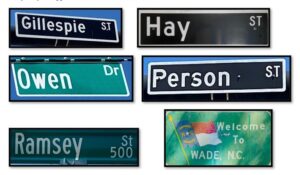
1783: A few of the appointed commissioners

1983: This statue was erected by the Lafayette Society on Fayetteville’s Bicentennial Anniversary
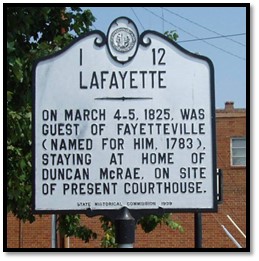
Fayetteville is the first city to be named for Lafayette and the only city named for him that he visited.

TravelStorys
Explore Lafayette’s visit to North Carolina with this interactive video tour. You can take a virtual tour of each location by clicking on the white arrow on the “Lafayette in North Carolina” video below, moving the map (scroll south to see Fayetteville), and then clicking on the story sites on the map. You can also enjoy the tour on location by downloading the TravelStorys app for free. The audio, text, and images will launch automatically as you approach each story site.

Follow the Lafayette Trail!
For a listing by location or by dates of the cities that Lafayette visited during his Farewell Tour, visit the website for The Lafayette Trail. This computer mapping project, founded by Frenchman Julien Icher, traces Lafayette’s travels across America in 1824-25. The AFL supervised the project during its founding between 2017-2019 and supported it with numerous donations. Later, Julien coordinated the installation of Lafayette Trail signs as physical corollaries of the computer maps. The signs were donated by the Pomeroy Foundation of New York. In 2021, Fayetteville became one of the first cities awarded a sign. Check out the video below to learn more about Fayetteville and our marker!
